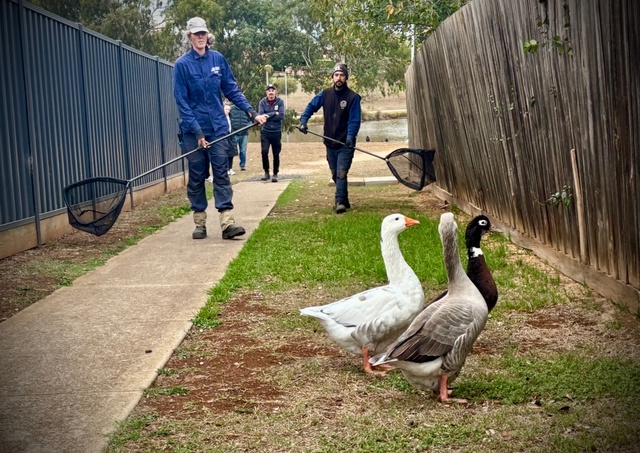Memorable rescues of beloved, quacking lake residents also serve as a reminder of the silent suffering animals endure due to careless recreation.
Rescuers are aiming to shine a light on a troubling trend: the dumping of domestic birds in public spaces.
The illegal and unethical release of domesticated waterfowl into public environments is at the forefront of growing concerns.
Domestic ducks and geese lack the necessary skills for survival. Most cannot fly to escape danger, are easy targets for predators, and often suffer from malnutrition when fed inappropriate food like bread.
Rescuers from Edgar’s Mission animal sanctuary recently came to the aid of Nautilus, a gentle Pilgrim goose found with a barbed hook lodged dangerously in his neck at Navan Park—just weeks after the rescue of Neil Diamond, a domestic Cayuga duck discovered with a fishhook embedded in his bill at Caroline Springs.
Abandoned birds, discarded fishing hooks, poor diets, predation, and human cruelty are the root causes behind some of the most distressing rescues.
Nautilus’s rescue was swift—thanks to his trusting nature. He seemed to instinctively understand the rescuers meant him no harm. But he wasn’t alone. His lifelong mate, Neptune, and an unexpected companion—Nathan, a crossbred Muscovy duck—were also taken to safety.
The trio was transported in Edgar’s Mission’s “Kindness Van” to a local veterinarian, where the hook was carefully removed from Nautilus’s neck.
Pam Ahern, founder of Edgar’s Mission, explained that Pilgrim geese form lifelong bonds, often remaining with the same mate for up to 20 years.
“To leave Neptune behind would have been heartbreaking. These animals are not just ornamental lake residents—they are living, feeling beings,” she said.
The Edgar’s Mission team has confirmed that none of the rescued birds will be returned to Navan Park Lake, where they would continue to face threats—not just from discarded fishing hooks, but also from predators, inadequate diets, and human mistreatment.
“The fishhooks removed from Neil Diamond and Nautilus—and the many more scattered around local waterways—are painful reminders of the silent suffering caused by careless recreation,” Ms Ahern said.
In response, Edgar’s Mission is encouraging the public to connect with wildlife in safer, more compassionate ways:
-Photograph local wildlife rather than capturing or feeding them
-Sketch or paint native species to appreciate their beauty
-Participate in community clean-ups around lakes and wetlands
-Support wildlife sanctuaries and habitat conservation
-Educate others, especially children, about empathy and coexistence







